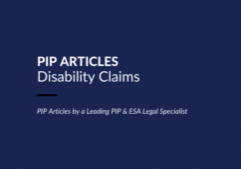What you need to know about PIP rates and components
Personal independence payment (PIP) is the disability benefit for people of working age. Since 2018, it is the only disability benefit that such people can apply for, and the Government continue to move claimants from the benefit it has replaced, disability living allowance (DLA). Both benefits acknowledge long-term illnesses or disabilities, so that although a broken leg, for example, may severely limit what that person can do, it will hopefully heal completely and their ability to function will return to normal, so they would not have a claim.
DLA was made up of two components, mobility and care. PIP is similar in that respect, since you have the daily living and the mobility components. Each component can be paid at either a standard or an enhanced rate. The value of standard rate daily living component in PIP is the same as middle rate DLA care component (£58.70 a week in 2018/19), and enhanced rate daily living is worth the same as highest rate DLA care (£87.65).
It is very much the same with mobility; standard rate for 2018/19 is £23.20, just like Lower rate DLA mobility component, while enhanced rate PIP mobility is £61.20 a week, the same as the higher rate DLA mobility component.
PIP is a points-based benefit, unlike DLA. Scoring less than 8 points for either component of PIP will give no award. A score of between 8 and 11 points gives an award of the standard rate, and 12 or more points are needed to get the enhanced rate. So, scoring say, 7 points for daily living and 4 for mobility would give no award; the scores for each component are not added together.
Many clients are particularly concerned about their award of mobility, sometimes because they cannot otherwise afford the taxis that they must use; others need access to the Motability Scheme for a car and running costs. To use the Motability Scheme, enhanced rate is needed, and this raises a disadvantage with PIP, as well as one of the ways in which it is better. With DLA, the only way to have higher rate and access to the Motability Scheme was to be awarded the higher rate, which for most claimants meant being assessed as ‘virtually unable to walk’. There were different ways to achieve this, but looking just at the distance that the claimant could walk, the distance they could manage, before being in ‘severe discomfort’ had to be no more than 50 metres. Mobility for PIP is somewhat different, but if we continue to focus on the distance that someone can walk, then to get enhanced rate, that distance comes down to 20 metres.
Some people will be helped by one of the ways in which PIP is an improvement over DLA. That benefit looked at the physical ability to walk and mental health impacts on mobility quite separately so that limitations with thinking, sight loss, epilepsy or problems with anxiety or depression could not be added to physical limitations with walking, to get someone onto higher rate mobility component of DLA. This is exactly what can happen with PIP. This allows some people to get enhanced rate PIP mobility who could not have qualified for higher rate DLA mobility.
There are advantages for PIP over DLA on the daily living/care side too. For someone to get the highest rate of the care component of DLA, they had to have sufficient day time and night time needs. The only exception was if a person was assessed by their consultant as suffering from a ‘terminal illness’. A person with considerable daytime needs, but who had little need for either help or supervision during the night, could not be awarded more than middle rate DLA care component. With PIP, there is no separate assessment of daytime and night time needs. If the person scores 12 or more points, they qualify of enhanced rate daily living component. Many people who could not have qualified for the highest rate of DLA care can get enhanced rate with PIP. The difference between standard and enhanced rate daily living component is £28.95 a week or £1,505 over a year. The difference between the two rates of the mobility component is even greater, £38 a week or £1,976 over the course of a year.


 PIP Appeal Tribunal Awarded Six Times The Number Of Points Awarded By The DWP
PIP Appeal Tribunal Awarded Six Times The Number Of Points Awarded By The DWP